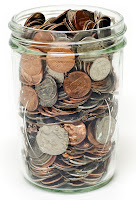Ok, here comes the hard part. It's kinda like stepping on the scale for your first weigh-in. But, as painful as it is, you have to know where you started in order to know if you're improving. (See, I did learn something from my Six Sigma Greenbelt training!)
Today I'm going to revisit and update the benchmarks for how much Matt & I currently spend each month in four categories (below). I'll keep the actual numbers private (because some things are sacred even in the blogosphere), but I'll share the process I went through to figure it all out and how I plan to track spending going forward. You may have a better way to do this, so please drop me a comment if you have any suggestions.
1. Home - including mortgage payments, insurance, taxes and utilities.
2. Cars - including car payments and insurance.
3. Credit/Debit Cards - Matt and I pay for almost everything with our credit cards (but never carry a balance). I like it better that way because it's easier to see where the money went and we usually end up with a nice Cashback Bonus from Discover Card every year. This is obviously where the most variability in our spending occurs - and the biggest opportunity for us squeeze out some savings. I'll break this down into subcategories to get a better idea of what's fixed and what's not.
4. Cash - Like I said, we use plastic for most purchases - but there are the occasional trips to the ATM. We currently keep no record of how much cash we spend or where it goes - so there may be some hidden savings gems here, too.
About a year ago when quitting my job became a real possibility, the first thing I did was create a new spreadsheet (of course!) to get a feel for how it would affect our finances. It's been a good tool to make sure we kept our spending within a loose budget - but now it's time to update it and get down to business saving money. I'll try to figure out how to post it for you to use as a template. In the meantime, it's so basic that I'll just describe it below.
I labeled column A "Income (after taxes)" and listed "Matt's monthly income" and "Kelly's monthly income." I had to login to our bank account to verify Matt's monthly take-home and then I entered the value in the corresponding field in column B. I put a big goose egg for my monthly salary - though I certainly intend to do much better than that, this is a good exercise to see if living on one paycheck puts us in the red or not.
I labeled column C "Expenses". (I know...rocket science, right?) Make sure this column represents all the money going out each month.
Here's what I listed in column C with the values listed in column E (column D has my Credit Card subcategories):
Mortgage
Energy
Taxes
Cable
Car Payments
Car Insurance
Credit Cards (with the following subcategories listed in column D: Groceries, Gas, Gym Memberships, Cell Phone, Haircuts, Charity, Eating Out, Apparel, and Misc.)
Cash
The fixed expenses for home and car were easy, but it took a little bit of work to fill in the rest of the blanks. Had to really disect our credit card statements (going several months back) and tally up the totals for each category. Since spending varies from month to month, I tended to be conservative (rounded up) with the amounts so I didn't underestimate our actual spending.
To finish up the spreadsheet, I put totals at the bottom of columns B and E; labeling them as "Total Income" and "Total Expenses", respectively. Below the total expenses, I calculated the magic "Gain/Loss" value by subtracting total expenses from total income and prayed the number would be greater than zero. Hallelujah!
Now the trick is to dig into each of our spending buckets and figure out where the leaks are. Should be fun!
If you want more information, just Google "tracking spending" and you'll find many other blogs and sites tackling this subject. I'll explore them and tell you my favorites in another post.






